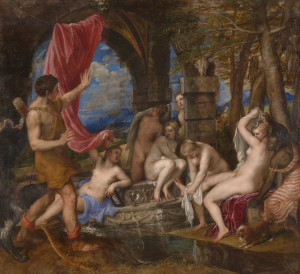Self Portrait at the Easel Painting a Devotional Panel
Born cerca 1532 in Cremona, Italy; died November 1625 in Palermo
Though there were many deserving female artists before Sofonisba Anguissola, I find it most appropriate to begin with a painter from the Italian Renaissance— the “rebirth” of art, culture, and science in Europe. Encapsulating the progressiveness of the time period, Anguissola’s wealthy father sent her and her sister to receive a proper education under the tutelage of Bernardino Campi, an established painter. The young Sofonisba quickly flourished, and with the help of her father, rose to prominence across not only Italy, but the rest of Europe, as well. She even became acquaintances with the famed Michelangelo, who appreciated her work and offered guidance. In 1559 she arrived in Madrid, Spain to work for the royal court of Philip II, where she remained for twenty years painting detailed, formal works of the family. After two marriages (the first left her widowed) and a vast array of paintings to her name, Anguissola died at the age of 93 in her native Italy.
Though she did reach a great level of fame in her time, Anguissola also met difficulties due to her sex. Women were not allowed to learn about anatomy or draw live nude figures, so for much of her life she mainly painted portraits of what was openly observable, such as her family and herself. Nonetheless, her illustrious career, spanning over 70 years, helped to pave the way for future female artists. For a long period after her death, however, her works were frequently falsely attributed to male artists such as Titian and Leonardo da Vinci. It wasn’t until the last century that the art world really began to give Anguissola the credit she so rightfully deserved.
Below is the painting, Diana and Actaeon, by the aforementioned artist Titian.
Personally, I think this piece, and many others of Titian’s, is vastly different from the works of Anguissola. It’s strange to me that historians were so quick to attribute her paintings, which were of royalty or self-portraits, to an artist whose works tended to be grandiose depictions of myths and religion. This phenomenon is a prime example of history’s tendency to overlook women, sometimes even rewriting events to better suit a male-based narrative.
When looking at Sofonisba Anguissola’s paintings, my favorite is certainly her early portrait entitled, The Chess Game, depicting three of her sisters during a riveting match. Sofonisba was the oldest and had a brother and five younger sisters, three of whom she taught to paint. She clearly served as a sort of mentor for them, and I think this painting demonstrates the sisterly bond they all shared. The youngest sister is giggling and watching the next older sister, who in turn is observing her older sister. This cheery, brightly-colored scene provides a close look into their everyday lives, which I assume to be supportive of the endeavors they each undertook, whether or not they are traditionally “feminine” or not.
Anguissola was one of the first distinguished female artists that we have knowledge of, and really helped to set a precedent for those to follow. She created a great array of works throughout her prolific life though sadly many of her later pieces were lost in a fire. But, her memory persists in her remaining works and the great legacy she created.
One of Sofonisba Anguissola’s final Self-Portraits, 1620s
URLS:
http://www.britannica.com/biography/Sofonisba-Anguissola
http://www.britannica.com/biography/Sofonisba-Anguissola
http://clara.nmwa.org/index.php?g=entity_detail&entity_id=116





I love that you’re taking art and feminism and pulling them together here. Really nice job.
So three things:
The font is so big. I wonder if you could size it down a bit; it seems a little cartoony.
Who is your audience? How and why would they find you or be interested in what you’re writing about?
I think having a page that describes your reason for doing this would be useful.
Nice first go!
As someone who is admittedly naive when it comes to art- your writing is successful in drawing my attention to this artist. I really like how you include pictures of the artist’s work throughout the post as opposed to just the beginning or end, it makes the reading a lot easier on the eyes than it otherwise would have been. If I had one suggestion it would be that I found the topic a little hard to jump into from this post alone, kind of like what Professor Bedell was describing at the beginning of today’s class. I caught the drift though quickly, so I wouldn’t be too concerned. I can’t wait to see which female artist you showcase next!
Well, I think this woman is clearly an unbelievable painter, especially considering the limited resources she had access too, given her gender. I loved the way this post was written. I think the topic had the potential to be either very interesting or very dry and historical. You did a great job keeping it interesting and I thoroughly enjoyed reading it, despite the fact that I am not a fan of history. The images of the paintings you included also made it extremely enjoyable to read. All in all, I very much enjoyed reading this.
Now, there is one thing you wrote that I do have a comment on. You said that historians were quick to favor a male-favored narrative. Though I agree with this, I think that this is more due to the fact that historians were aware of the sexism of the age in which the painting dates back to, less than it is due to the fact that the historians were, themselves sexist.